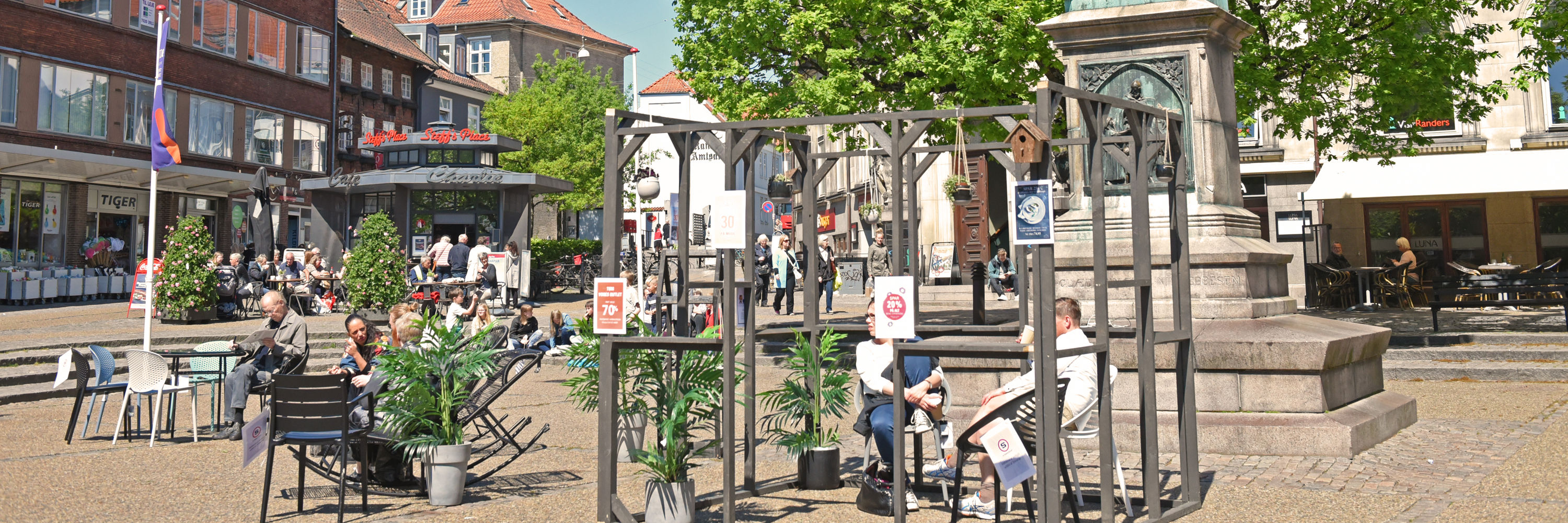
History
The history of Randers can be traced back to around the year 1000.
Early history (approx. 1000-1400)
It is unknown when the Randers was founded precisely, but around 1080 there was a mint in Randers, as the city already at that time was a well-known trading centre.
The city was destroyed and rebuilt three times in the 13th century. In 1246, it was burned down by King Abel of Denmark's troops during the civil uprising against King Eric IV of Denmark.
Randers was granted privileges as a market town in 1302, which created a significant amount of trade.
On April 1, 1340, Randers was the centre of one of the largest riots in the Denmark’s history when Danish nobleman and national hero Niels Ebbesen killed Count Gerhard III of Holstein. This happened during the Kingless Times, when the entire country was pledged to German counts, and led to further insurrection against the Germans. Niels Ebbesen died in a large battle at Skanderborg Castle in December 1340. A statue of Niels Ebbesen stands in front of Randers' City Hall today.
When King Valdemar IV of Denmark (Valdemar Atterdag) tried to assemble a government in 1350 after the mortgaging to the Holsteiners, Randers was further reinforced with protection and was often named as Randershus ("Randers Fortress"). This fortification was captured by dissatisfied nobility in 1357. In 1359, Valdemar IV attacked the captured Randers with the strength of all of his forces.
The Renaissance and autocracy (approx. 1400-1848)
Randers prospered in the 15th and 16th centuries trading both nationally and overseas thanks to its harbour and cargo shipping maintained by competent craftsmen. Salmon fishing also contributed to the local economy.
The town was fortified through much of the Middle Ages. Today, however, the only sign of the defensive walls is their existence in street names, including Østervold ("Eastern Defence Wall"), Nørreport ("Northern Gate"), Vestervold ("Western Defence Wall") and Lille Voldgade ("Little Defence Wall Street"). These streets follow a circular path, presumably following the location of the historic walls. In addition, massive moats were set up around the town under the rule of King Christian III (1536-1559).
During its peak, there were almost 170 merchants' estates in Randers and a sizeable navy that sailed around the world. You can still see some of the old half-timbered estates and manor homes in the town.
During the second half of the 17th century, the town suffered not only from the Swedish wars but experienced the plague and extensive fires. However, from the mid-17th century, the economy began to thrive once more, and the harbour was extended, which brought an increase in shipping. Furthermore, several impressive buildings were made, including the City Hall (Rådhuset).
By the end of the 18th century, Randers had become Jutland's largest town with 4,500 inhabitants.
Randers was already known for its glove-making in the Middle Ages, but at the beginning of the 18th century the industry really prospered.
Industrialization and modern times (1848-present)
During the industrialization, Randers became a centre for the developing agricultural industry, and a number of manufacturing businesses and heavy machinery factories also emerged. Randers was also known for salmon, rope and pretty women.
From the latter half of the 1800s, Randers grew in several directions, and a large industrial area emerged at the harbour. Particularly the crafts and industry sector grew, and Randers became one of the most important industrial towns in Denmark. Trade and seafaring continued to be major sectors of the local economy, and the harbour was expanded and improved several times during this era.
With the opening of the first railway line to Aarhus in 1862, the barge transports on the River Gudenå declined dramatically. This however paved the way for a booming railway manufacturing industry. Even though the population of Randers grew in these years, it was outpaced by Aarhus and Aalborg.
The cityscape changed dramatically in the 19th century with new, large factories, including The glove factory Randers Handskefabrik (established in 1811), the train factory Scandia (established in 1861), the Thor breweries (established in 1856) and the machine factory Dronningborg Maskinfabrik (established in 1894, also known as Dronningborg Industries abroad).
In 1935 a regional hospital was founded in Randers, located in the neighbourhood of Dronningborg.
In 1970, came a merger of smaller municipalities where the large suburban areas south, east and west of Randers were incorporated into a larger municipality.
On January 1, 2007, another merge occurred with the new Randers Municipality being formed from the old Randers Municipality, the former Purhus and Nørhald Municipalities, the western part of the former Sønderhald Municipality, large parts of the former Langå Municipality and the Havndal area of the former Mariager Municipality.
Visit the historical museum
If you are interested in learning more about the city's history, you can visit the historical museum – Museum Østjylland.